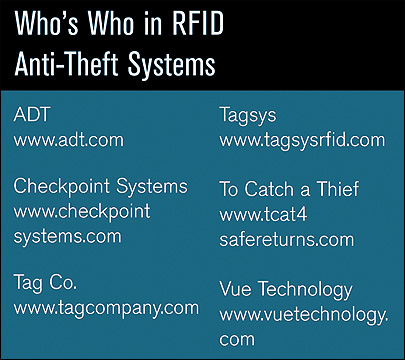In spite of electronic article surveillance (EAS) tags—those plastic tags that can be found on nearly every type of item in department and specialty stores—shoplifters and employees stole $30.7 billion from U.S. retailers in 2005; that’s up from $25.04 billion in 2001, according to the National Retail Federation. EAS tags transmit magnetic, radio or microwave signals to trigger alarms at store exits if they are not deactivated at the point of sale. Problem is, by then it’s usually too late. Many retailers dissuade employees from chasing thieves as they flee stores, because there’s no telling whether the thief has a weapon or an accomplice who could cause harm.
Now some retailers are turning to RFID—in combination with other security systems—to thwart thieves before they get to the door, as well as to curb employee shoplifting in stock areas. If shoplifters do get away with the goods, RFID could provide visibility into what was stolen, facilitating the replenishment of store shelves and inventory. And RFID could reduce the incidences of fraudulent returns.

One system from Vue Technology and the Tag Co., which is being tested by a number of retailers, tracks tagged items on RFID-enabled shelves. The items can be tagged with separate RFID and EAS tags or hybrid RFID-EAS tags. The system is designed to alert retailers to a possible theft, such as a sweep in which a thief clears an entire shelf of a particular product. The smart shelves send real-time inventory lists to Vue’s IntelliManager software, which links with the Tag Co.’s EAS software.
If a number of items are removed from a shelf, the IntelliManager sends an alert to the EAS software, which in turn sends a red flag, detailing the location of the shelf, to store security. Store personnel can then determine whether a theft is occurring or if it’s a false alarm, such as a shopper removing a number of items from a shelf while hunting for a particular size or style.
Checkpoint Systems, a provider of EAS tags and readers, is developing a hybrid tag that combines its proprietary EAS technology with standard UHF RFID tags. At its RFID Innovation Center in Neuss, Germany, retailer Metro AG is testing an RFID-EAS tag from retail security and RFID vendor ADT. Checkpoint and ADT don’t believe retailers are ready to switch from the EAS systems they have in place today to a fully RFID-powered system. Retailers also don’t want the additional expense and time needed to apply both EAS and RFID tags to goods. These types of dual EAS-RFID tags could be used in a system such as the one developed by Vue and Tag Co.
Another solution from Tagsys combines RFID technology with the networks of digital surveillance cameras used by most retailers today. The Tagsys software controls smart-shelf interrogators and uses business rules to analyze the movements of tagged goods on shelves, similar to the way the Vue software looks for clues to a possible theft. The system also links to the software that controls the security cameras; it can direct a nearby camera to the smart shelf where suspicious activity may be taking place.
While RFID surveillance systems can boost store security, they’re not foolproof. Someone could grab tagged items and dash out the door. If the items carried just EAS tags, they would alert stores to a theft in progress. But if the items had RFID tags—and the retailer had installed RFID interrogators at store exits—the RFID system could tell managers what products, and how many of them, were stolen. That would help retailers avoid a double whammy—the loss of stolen goods and the loss of sales from empty shelves.
Of course, a savvy thief could remove an RFID hang tag or RFID-EAS tag from an item—without being caught on camera—leave the tag on an RFID-enabled shelf and run out the door. For that reason, Uwe Quiede, RFID project manager for German department store Galeria Kaufhof, says his company plans to wait until RFID tags are embedded directly into the fabric or materials from which products are made before testing RFID-enabled anti-theft systems.
David Cox, an Illinois-based entrepreneur, has secured a patent for an RFID-based solution that combats a different form of theft: return fraud. That happens when scammers bring in stolen or knock-off goods for a “return,” then walk out with their retail value in cash. Return fraud costs retailers an estimated $16 billion annually and is difficult to fight, since most retailers don’t use serial numbers to track the individual items they sell. The system, called To Catch a Thief, would enable retailers to use RFID for purchase authentication, which retail point-of-sale systems are not yet able to do.
Cox’s vision is to have a retailer encode a unique number to an RFID tag attached to a product at the time of purchase, using a reader integrated into the POS system. When a consumer returns an item to the store, the retailer would read the tag’s unique number. If the item no longer has a tag or the proof of purchase isn’t encoded to it, the store would not accept the merchandise. Cox says he is currently in discussions with a retailer to pilot the system, which could be deployed with any type of RFID tag.


